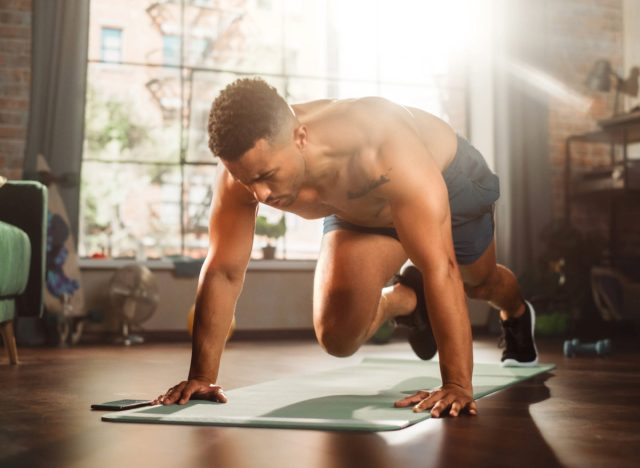If You Can Do This Many Mountain Climbers Without Stopping, Your Endurance Is In The Top 10%

Mountain climbers might look simple but don't be fooled. They're a full-throttle test of your stamina, strength, and mental grit. They combine the explosive intensity of sprinting with the core stability of a plank, pushing your cardiovascular system and muscles to their limits. When you're cranking out mountain climbers, your heart rate spikes, your lungs work overtime, and nearly every muscle from your shoulders to your calves is firing in sync.
Whether you're an athlete, a fitness enthusiast, or someone striving to elevate your workouts, mountain climbers offer a quick and effective way to assess your endurance and core strength. They provide a benchmark for your fitness level, showing how long you can sustain high-intensity effort and maintain form under fatigue. And if you can hit a high rep count without stopping, you're not just keeping up—you're setting the pace.
So, how many mountain climbers should you be aiming for? And what does that number reveal about your overall fitness? Stick around as we break down what elite performance looks like and share expert strategies to help you boost your stamina, build strength, and crush your goals.
Why Mountain Climbers Are a True Test of Stamina

Mountain climbers deliver a one-two punch of cardio and strength benefits, making them a powerhouse move for building endurance. You engage your shoulders, core, hip flexors, and quads by driving your knees to your chest in a plank position. The rapid-fire movement demands coordination and stability, challenging your cardiovascular system while enhancing your agility and balance.
On the cardio front, mountain climbers elevate your heart rate quickly, improving cardiovascular health and boosting calorie burn. Meanwhile, they strengthen the muscles needed for running, jumping, and explosive athletic movements, translating to better performance in sports and daily activities. Because they're a compound exercise—meaning they engage multiple muscle groups simultaneously—mountain climbers also improve functional strength, helping you move more efficiently and powerfully in real-world scenarios.
When performed at a high intensity, mountain climbers push your anaerobic capacity, testing how well your body can sustain effort under fatigue. This makes them a perfect benchmark for assessing your endurance and ability to maintain form when the burn sets in.
How Many Mountain Climbers Without Stopping Is Considered Elite?

Here's a quick breakdown of what your mountain climber count might say about your fitness:
- Beginner: Fewer than 50 mountain climbers
- Intermediate: 50–70 mountain climbers
- Advanced: 70–90 mountain climbers
- Elite: 90+ mountain climbers
To count your reps correctly, remember that one "climber" is a single knee drive, so bringing both knees to your chest counts as two reps. Your stamina and conditioning are truly next-level if you can keep a consistent pace and hit the elite mark!
How to Improve Your Mountain Climber Count and Build More Stamina

Want to dominate the mountain climber challenge? These strategies will help you build strength, endurance, and speed.
1. Build Your Cardiovascular Endurance
A solid cardio base is essential for high-rep mountain climbers:
- Interval Training: Perform 30-second sprints followed by 30 seconds of rest to build anaerobic capacity.
- Steady-State Cardio: Go for runs, cycle, or row for 20–30 minutes to enhance aerobic endurance.
- HIIT Workouts: Mix mountain climbers with exercises like burpees and jump squats to improve stamina.
2. Strengthen Your Core and Hip Flexors
Since mountain climbers demand a strong core, target it with:
- Planks (Front and Side): Build stability to maintain a strong plank position.
- Hanging Knee Raises: Strengthen hip flexors and lower abs.
- Russian Twists: Enhance rotational strength and core control.
3. Develop Leg Speed and Agility
The faster your feet move, the more reps you'll crush:
- High Knees: Perform high knees for 30-second intervals to improve quickness.
- Agility Ladder Drills: Boost coordination and foot speed.
- Jump Rope: Enhance rhythm, timing, and lower-body endurance.
4. Master Your Mountain Climber Form
Form is everything when you're aiming for high rep counts:
- Keep Your Core Engaged: Prevent your hips from sagging or bouncing.
- Maintain a Strong Plank Position: Your body should form a straight line from head to heels.
- Drive Your Knees to Your Chest: Move with control and avoid letting your feet drag.
Final Tips for Success
- Test Yourself Regularly: Perform a mountain climber test every 4–6 weeks to track your progress.
- Log Your Workouts: Keep track of your reps, sets, and training variations to monitor gains.
- Prioritize Recovery: Your body needs rest to adapt and improve—don't skip stretching, mobility work, and rest days.
And if you enjoyed this article, don't miss How Long Your Walking Workout Should Be To Shrink Belly Fat.









